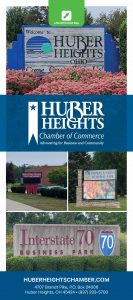The City of Huber Heights was known as Wayne Township prior to incorporation in 1981.
The existing history of Huber Heights as a community is largely shaped by its past history. It is also to the past that we must look in order to identify those elements, events, and attitudes that will serve as the foundation for further defining the City’s image.
Wayne Township is named in honor of Major General Anthony Wayne. George Washington named him Commander-In-Chief of the United States army in April of 1792.
He was probably best known in this part of the country for his decisive victory at the Battle of Fallen Timbers, what is now Toledo, Ohio.
Wayne Township, formed January 1, 1810, occupies the northeastern corner of Montgomery County. It joins Miami County on the north and Clark and Greene Counties on the east with Greene County also being a part of the southern border. The first township election was held at the house of Benjamin Van Cleve on Stauton Road on January 20, 1810. In 1917-18, the Wayne Township Centralized School was built on the site of what today is Titus Elementary School. In 1946 the first firehouse was built in the township located in what is today the Miami Villa Plat. By 1950, the population of the township was estimated at 1,921 persons.
In 1956 Charles H. Huber started the first privately owned utility company in Ohio and launched the construction of his first plat of brick, single-family homes. Over the period 1956-1992, Huber Homes built a total of 10,707 single-family homes and 2,258 multi-family units in the community. The late 1950’s also saw the construction of Interstate 70 through the northern section of the township, an event that also had a major impact on the future development of the community.
As Huber Homes continued building over the years, the population of the township grew significantly. By 1960, the township’s population had risen dramatically to 12,022 persons. By 1970, this figure had leaped to nearly 28,000. Today, the population is over 40,000.
In November of 1981, the electors of the City voted for a city charter, which gave the City home rule powers and established a modified council-manager form of government.
The physical layout of older American communities was designed such that a clearly defined “downtown” area was provided which would serve as the central meeting/gathering place for residents and visitors. Almost all of these downtown areas typically included a central square or common area within which and around various public improvements and amenities were provided in order to draw people to the area and facilitate their social interactions. Prior to World War II, the significance of the downtown area as central meeting place was reinforced by the fact that the bulk of the community’s residential population base was located within close proximity of the downtown area, and most major commercial, retail and service establishments were also located downtown.
The 1990’s brought a surge in commercial and industrial development around the various residential plats. The North Heights Plaza and Northpark Center brought numerous retail and commercial establishments that expanded the shopping opportunities for the residents. 1994 brought the development of Center Point 70 Commerce Park. Between 1994 and 1998, over 15 manufacturing businesses opened, employing over 1,700 people. In 1998, close to 700 businesses were established in Huber Heights. From 1998 to 2004, Executive Blvd. was expanded from Old Troy Pike to Brandt Pike bringing in FedEx, Yellow Freights along with other transportation and manufacturing companies. Coca-Cola located north of Interstate 70 opening another commercial area on Coca-Cola Way. The first phase of the Carriage Trails Community broke ground in November 2003 and there are plans for a future school and fire station in that community. In 2005 The Oaks of Huber Heights and Artisans Walk began building and the Huber Heights YMCA opened its doors as the newest addition to the City of Huber Heights.




















